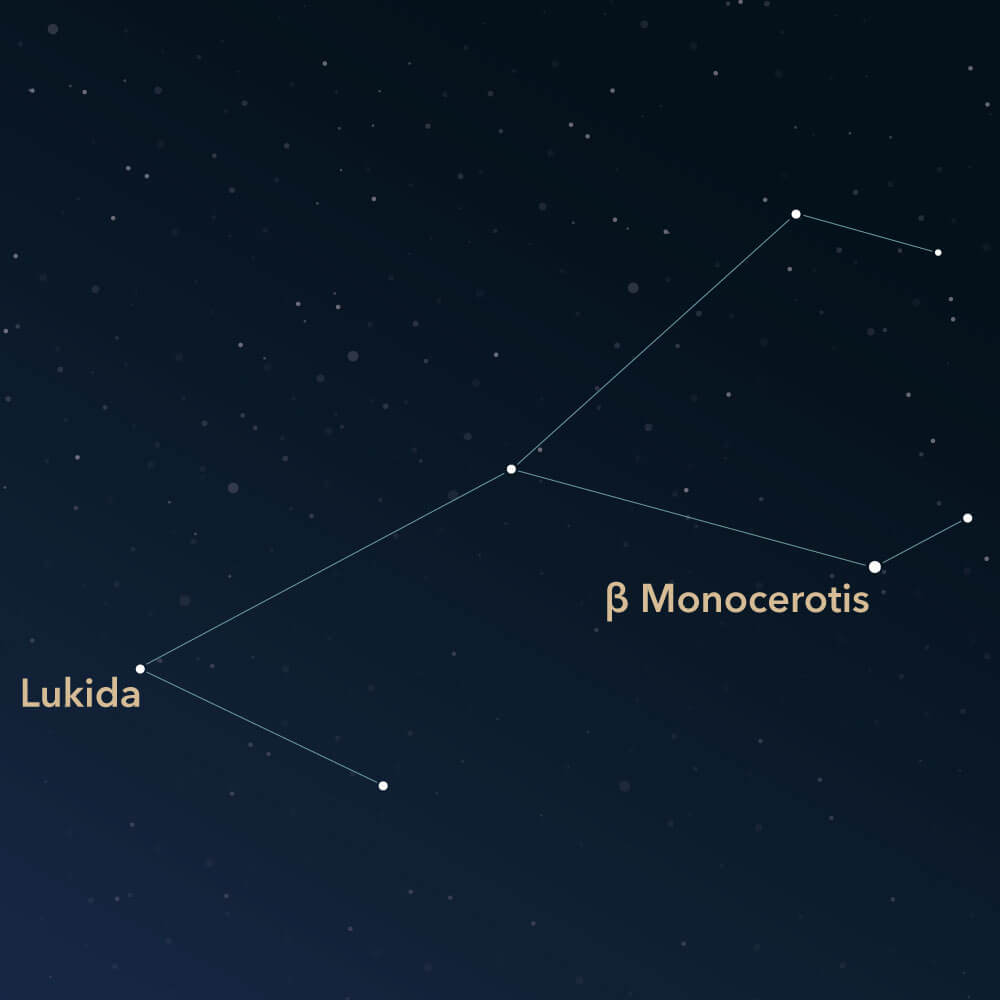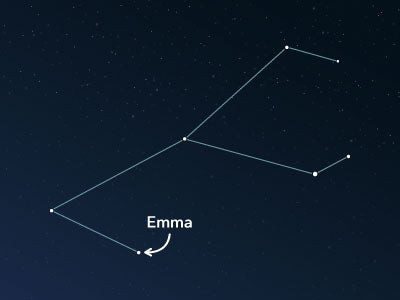The constellation Monoceros
Caratteristiche
- Nome latino
- Monoceros
- Emisfero
- Entrambi gli emisferi
- Visibilità
- October - April
- Area
- 482 deg²
- Stella più luminosa
- β Monocerotis (HIP number 30867)
- Specialità
- Open star clusters, emission nebula, reflection nebula

The Monoceros symbolizes a unicorn, by which name it is commonly known. It is an inconspicuous constellation located north of the brightest star in the night sky. The constellation does not contain particularly noticeable stars, but it has interesting deep-sky objects.
Hemisphere, visibility, and area
The Monoceros stretches across the equator and is visible in both hemispheres. It can be observed from locations between latitudes 78° N and 78° S, which correspond to regions such as Greenland's northernmost part and Antarctica's northern areas. Therefore, it is visible from almost all inhabited regions of the earth.
The best time to see the constellation in the night sky is between October and April.
Compared to all other 88 constellations, it is medium-sized with an area of about 482 square degrees. However, it is not particularly prominent, as there are primarily faint stars in the region of the Monoceros.
Only two stars are brighter than the fourth magnitude. With an apparent magnitude of roughly 3.76, β Monocerotis (Beta Monocerotis) is the most shining star in the constellation of the Monoceros. It is a triple-star system consisting of three stars orbiting a common center. The system is about 691 light-years away.
To locate the constellation in the night sky, it is helpful to look for neighboring constellations. The very bright star Sirius also helps with orientation, as it lies directly south of the Monoceros.
Sirius is a star in the well-known constellation Canis Major (also known as Greater Dog). Together with the constellations Puppis, Hydra, and Canis Minor in the south, it borders the Monoceros. In other directions, the constellations Gemini, Orion, and Lepus are neighboring it.
Specialties in the constellation
The Monoceros is located amid the Milky Way and therefore contains several interesting objects, such as open star clusters, an emission nebula, and a reflection nebula.
One of the open star clusters is NGC 2323, also known as M50 (Messier 50). It was discovered by the Italian astronomer Giovanni Domenico Cassini in 1711. Approximately 60 years later, Charles Messier added it to his catalog of nebulous objects. M50 has an apparent magnitude of about 5.9 and is located about 3,000 light-years away from the solar system. Its age is estimated to be a maximum of 140 million years. Compared to other open star clusters in the Milky Way, it is one of the younger ones.
The star cluster can be found in the middle between the stars Lukida (α Monocerotis, Alpha Monocerotis) and β Monocerotis (Beta Monocerotis). It is already visible in a prism binocular.
In addition, the emission nebula NGC 2237, also known as the Rosette Nebula, lies in the Monoceros.
The Rosette Nebula consists of several open star clusters embedded in a diffuse emission nebula. The luminous stars of the star clusters cause the surrounding gas clouds to glow. In a telescope, denser regions can be observed. However, to discern more detailed structures, long-exposure photography is required.

Another nebula in the Monoceros is the NGC 2261 or Caldwell 46. It is a variable reflection nebula illuminated by a young giant star. The nebula is approximately 2,600 light-years away from the sun. In a telescope, it appears like a small comet.
Mythology and history
According to the German astronomers Heinrich Wilhelm Olbers and Ludwig Ideler, the constellation was already depicted on a Persian celestial globe in 1564.
Another version states that the Dutch cartographer Peter Plancius described the Monoceros in 1612 when creating his celestial globe.
Finally, the German astronomer Jacob Bartsch included the constellation in his star chart in 1624 under the name "Unicornus."
As a mythical creature, the unicorn has been attributed to a Christian motif. While modern bible translations speak of buffaloes, the unicorn was mentioned several times in the past. It was interpreted as Jesus Christ with a horn that represented divine truth.
PubblicatoLeggi altri articoli interessanti

An overview of all 88 constellations
Learn more about all 88 constellations and read interesting information about the mythology, visibility, and features.

App Planetario
Discover the night sky with our planetarium app!
Available for iOS and Android.

Dai un nome a una stella nella costellazione Unicorn
Name a star in a constellation and create something that lasts for eternity.